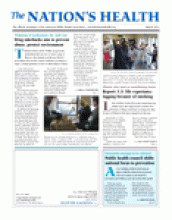Cities — bustling hubs of commerce, higher education and culture — are now home to half the world’s population. But amid the skyscrapers, art museums and universities, pockets of people suffer disproportionately from poor health, according to a new report that calls on policy-makers to identify deprived populations and develop targeted measures to improve their health.
The report, published in November by the World Health Organization and the United Nations Human Settlements Programme, looks at the population characteristics of city dwellers — such as their socioeconomic status and the neighborhoods in which they live — to demonstrate that poor health is linked to poverty in urban areas. In developing the report, researchers looked beyond city averages to identify clusters of people suffering from poor health and social deprivation. Previous efforts, according to WHO, focused largely on data averages and on differences between cities. For example, although child survival rates in the world’s urban areas are mostly higher than in rural areas, the averages obscure “substantial inequities” between population groups, and the poorest urban children are twice as likely as the richest to die before age 5.
“Averages hide large pockets of disadvantage and poor health, concealing the reality of people’s lives,” said WHO Director-general Margaret Chan, MD, MPH. “This new analysis uncovers gaps in health and health care access across urban populations, and shows city leaders where their efforts should focus.”
The report notes that unless urgent action is taken to address urban health inequities, countries will not achieve the health-related Millennium Development Goals.
The urban poor suffer disproportionately from a range of diseases and health problems, the report found. For example, families with the lowest incomes and education levels in urban areas have reduced access to skilled birth attendants, which puts them at greater risk for complications during childbirth. The urban poor are also disadvantaged in terms of their living conditions. Access to clean water, for example, has improved around the globe over the last two decades, but substantial inequities persist between the richest and poorest urban residents in countries such as Africa and Asia, where access to clean, piped water corresponds to increases in wealth.
Emphasizing that health inequities exist in cities around the globe — in developed as well as developing countries — the report found that bigger cities tend to have wider gaps in tuberculosis rates. For instance, within the city of Osaka, Japan, some day laborers suffer tuberculosis rates that are nine times higher than the area in the city with the least tuberculosis, showing that the disease rates reflect economic and social disadvantage.
Life expectancies within cities reflect inequities as well, and vary drastically between a city’s affluent and poor communities, said the report. For example, people living in certain poor neighborhoods in New York City are less likely to have access to essential health care and more likely to suffer the worst health outcomes, as reflected in life expectancy rates and death rates from AIDS.
“All too often, policy-makers and planners fail to understand that with the urbanization of poverty, many slum dwellers suffer from an additional urban penalty: They have a higher rate of child mortality, die younger and suffer from more diseases than their more affluent neighbors,” said Joan Clos, executive director of UN-Habitat. “To better understand the causes of poor health, the report focuses on several factors including population dynamics, urban governance, the natural and built environment, the social and economic environment, and access to services and health emergency management.”
The report’s findings can be used by city leaders and policy-makers to look at trends, even within neighborhoods, and understand differences within cities as well as between them, the report noted.
To download “Hidden Cities: Unmasking and Overcoming Health Inequities in Urban Settings,” visit www.who.int/mediacentre/news/releases/2010/hiddencities_20101117/en/index.html.
- Copyright The Nation’s Health, American Public Health Association









